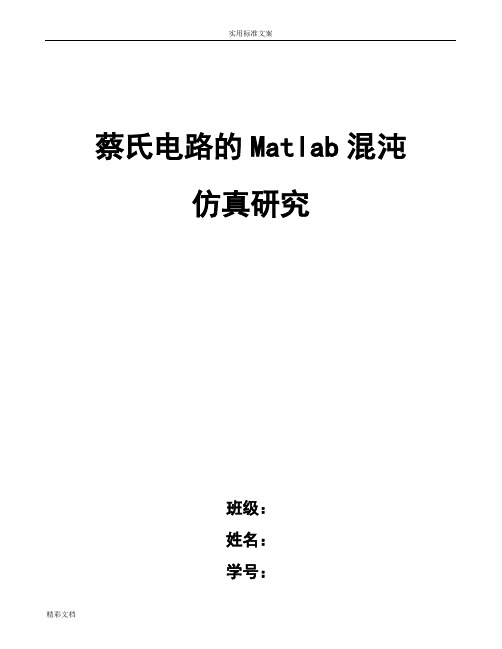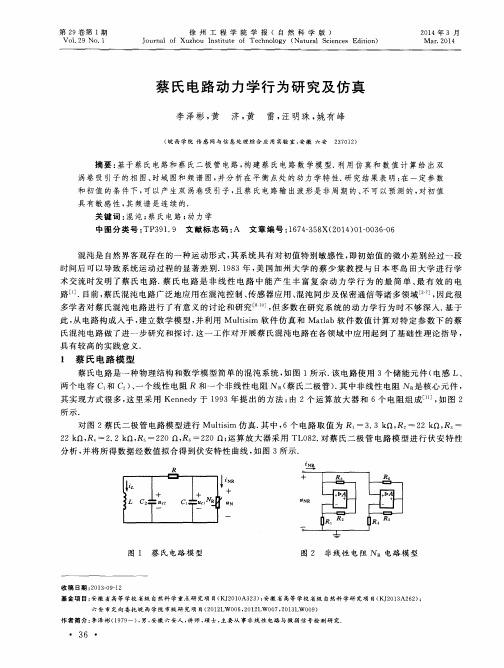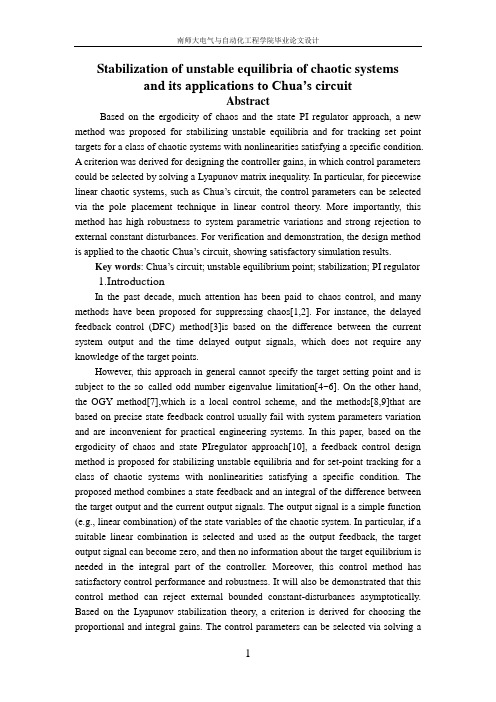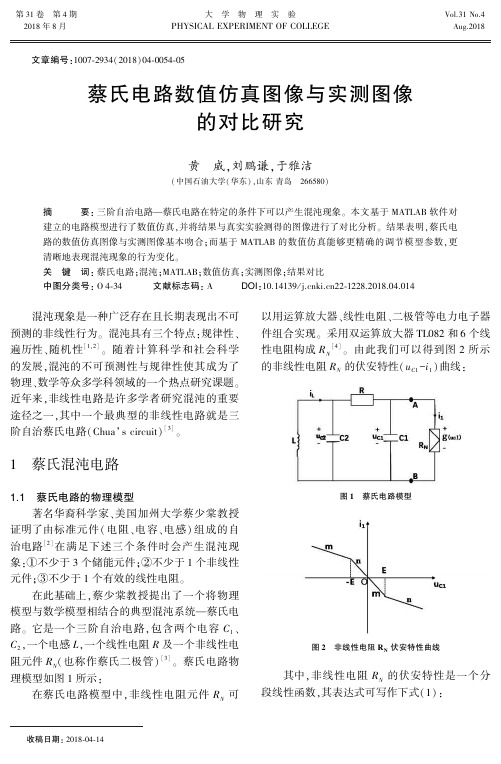蔡氏电路的建模_仿真及混沌稳定岛图的研究_刘孝贤
蔡氏电路MATLAB混沌仿真

蔡氏电路的Matlab混沌仿真研究班级:姓名:学号:摘要本文首先介绍非线性系统中的混沌现象,并从理论分析与仿真计算两个方面细致研究了非线性电路中典型混沌电路,即蔡氏电路反映出的非线性性质。
通过改变蔡氏电路中元件的参数,进而产生多种类型混沌现象。
最后利用软件对蔡氏电路的非线性微分方程组进行编程仿真,实现了双涡旋和单涡旋状态下的同步,并准确地观察到混沌吸引子的行为特征。
关键词:混沌;蔡氏电路;MATLAB仿真AbstractThis paper introduces the chaos phenomenon in nonlinear circuits. Chua’s circuit was a typical chaos circuit, thus theoretical analysis and simulation was made to research it. Many kinds of chaos phenomenon on would generate as long as one component parameter was altered in Chua’s circuit.On the platform of Matlab, mathematical model of Chua’s circuit was programmed and simulated to acquire the synchronization of dual and single cochlear volume. Meanwhile, behavioral characteristics of chaos attractor were observed.Key words:chaos phenomenon;Chua’s circuit;Simulation1、引言混沌理论的基本思想起源于20世纪初,完善于20世纪60年代后,发展壮大于20世纪80年代,被认为是继相对论、量子力学之后,人类认识世界和改造世界的最富有创造性的科学领域第三次大革命。
蔡氏电路毕业设计论文[管理资料]
![蔡氏电路毕业设计论文[管理资料]](https://img.taocdn.com/s3/m/99f3b0bf2b160b4e777fcf9b.png)
目录前言 (4)第一章混沌学基本理论 (4) (5)混沌的定义 (5)混沌的主要特征 (6)混沌的意义 (7)混沌的发展与前景展望 (7)蔡氏电路简介 (8)软件介绍 (8)第二章蔡氏电路理论分析 (10)蔡氏电路构成及蔡氏二极管 (10)蔡氏电路的数学模型 (14) (14)平衡点及稳定性 (15)第三章蔡氏电路的电路实验 (19)典型蔡氏电路仿真 (19)振荡吸收器 (23)等效电感 (31)第四章结束语 (34)第五章总结与心得 (36)参考文献 (39)致谢 (40)附录 (41)蔡氏电路混沌特性的实验研究摘要:混沌现象是一种确定性的非线性运动,在非线性控制领域,混沌控制的研究受到人们越来越多的关注。
典型蔡氏电路结构简单,但有复杂的混沌动力学特征,因而在混沌控制领域中成为研究的重要对象。
本次设计简单介绍了混沌学基本理论,从理论分析和仿真实验两个角度分别研究Chua's Circuit的混沌行为,用Multisim 软件对电路进行仿真实验,通过改变参数,得到了系统各周期的相轨图,并对实验中遇到的现象进行简单的讨论,将蔡氏电路与一个线性二阶电路耦合,得到了更加丰富的混沌行为。
由于普通蔡氏电路在产生混沌现象时,其元件参数可调范围很小,且对初始条件极为敏感,不易于搭建实验电路。
所以引入了电感等效电路,在本文的最后将蔡氏电路中的电感用等效电路替代,从而实现了无感蔡氏电路。
关键词:混沌;蔡氏电路;Multisim;振荡吸收器;等效电感Experimental Study of Chua's Circuit ChaoticAbstract:Chaos is a deterministic non-linear movement, in the field of nonlinear control, chaotic control get more and more attention by people. Typical Chua's circuit is simple, but complex and chaotic dynamics characteristics, so become an important research object in the field of chaos control . The design simple introduced the basic theory of chaos, study the chaotic behavior of Chua's Circuit from two angles of the theoretical analysis and experimental with Multisim circuit simulation software, by changing the parameters, get each cycle tracks phase diagram of the system, simple discuss the experimental phenomena encountered, couple the second-order Chua's circuit with a linear circuit ("oscillation absorber"), get even more chaotic behavior of the rich. As the general chaos in Chua's circuit in the production, its range of component parameters adjustable is very small, and extremely sensitive to initialconditions, hard to set up experimental circuit. Therefore introduce the inductor equivalent circuit, in this final, change the inductor of Chua's circuit with the equivalent circuit, thus achieving non- inductor of Chua's circuit.Key words:chaos; Chua's circuit; Multisim; vibration absorber; equivalent inductance前言“1979年12月,洛伦兹在华盛顿的美国科学促进会的一次讲演中提出:一只蝴蝶在巴西扇动翅膀,有可能会在美国的德克萨斯引起一场龙卷风。
仿真蔡氏电路混沌效应的教学讨论

仿真蔡氏电路混沌效应的教学讨论
蔡氏电路是一种混沌系统,其混沌现象在模拟电路领域非常重要。
仿真蔡氏电路的混沌效应,是电路仿真教学中的一个重要课题。
首先,混沌效应的探究是基于学生对混沌学理论的掌握和电路
仿真工具的运用。
因此,在教学过程中,应先向学生介绍混沌现象
和蔡氏电路的基本原理,让学生理解混沌是一种非周期性且不可预
测的现象,而蔡氏电路是一种具有三个不同周期的振荡器。
接着,教师可以使用仿真软件(如Multisim或LTSpice)进行
电路仿真,让学生通过仿真实验的方式来观察混沌效应。
学生可以
通过改变电路元件的参数(如电容、电阻等)来观察混沌效应的变化。
同时,学生也能够通过仿真实验来了解混沌系统的稳定性和可
控性。
在教学过程中,教师可以提供一些课堂讨论或小组讨论的环节,让学生可以对混沌效应进行深入的探究和分析。
例如,让学生讨论
如何通过改变蔡氏电路中的元件来改变电路的混沌状态,或者讨论
混沌现象在日常生活中的应用。
最后,在教学结束后,教师可以要求学生进行实验报告的书写,来总结混沌电路的基本原理、仿真过程、结果分析以及对混沌现象
的理解和探究。
通过这种方式,学生能够获得更深入的学习和理解,也能够提高其电路仿真和实验技能。
仿真蔡氏电路的混沌效应是电路仿真教学中一个重要的课题,
通过深入的探讨和分析,将有助于学生加深对混沌系统的理解和掌
握,提高其仿真和实验技能,也有助于学生将所学知识转化为现实应用。
蔡氏电路动力学行为研究及仿真

2 O 1 4年 3 月
M ar . 201 4
蔡 氏 电路 动 力 学行 为研 究 及 仿 真
李泽彬 , 黄 济 , 黄 雷 , 汪 明珠 , 姚 有 峰
( 皖 西 学 院 传 感 网与 信 息处 理 综 合 应 用 实验 室 , 安徽 六安 2 3 7 0 1 2 )
摘要: 基于 蔡 氏电路 和蔡 氏二极 管 电路 , 构建 蔡 氏 电路 数 学模 型. 利用 仿 真 和 数值 计 算 给 出双 涡卷 吸 引子 的相 图、 时域 图和 频谱 图 , 并分 析 在平衡 点处 的动力 学特 性. 研 究结果 表 明 : 在 一定 参数
和初值 的条 件 下 , 可 以产 生双 涡卷 吸 引子 , 且 蔡 氏 电路 输 出波形 是非周 期 的 、 不 可 以预测 的 , 对初值
具 有敏 感 性 , 其 频 谱 是 连 续 的.
关 键词 : 混沌 ; 蔡 氏电路 ; 动力 学 中图分 类号 : T P 3 9 1 . 9 文献 标志 码 : A 文章 编号 : 1 6 7 4 — 3 5 8 X( 2 0 1 4 ) 0 1 — 0 0 3 6 — 0 6
混 沌是 自然 界 客观存 在 的一种 运动 形式 , 其 系统具 有对 初值 特别 敏感 性 , 即初始 值 的微小 差别 经过 一段 时 间后 可 以导致 系统 运动 过程 的显 著差 别. 1 9 8 3年 , 美 国加 州大 学 的 蔡少 棠 教 授 与 日本 枣 岛 田大 学 进 行学 术 交 流时发 明了蔡 氏 电路 . 蔡 氏 电路 是 非 线 性 电路 中能 产 生 丰 富 复 杂 动 力 学 行 为 的最 简 单 、 最 有 效 的 电
具 有较 高 的实践 意义 .
蔡氏电路及混沌现象研究

蔡氏电路及混沌现象研究一、引言在非线性电路中蔡氏电路是迄今为止产生复杂动力学行为的最为有效和较为简单的电路之一。
混沌(chaos)现象的研究是非线性系统理论研究中的前沿课题之一,混沌现象普遍存在物理、化学、生物学,以及社会科学等等各个学科领域中,是在确定性系统中出现的一种貌似无规则、类似随机的现象,是非线性动力学系统特有的一种运[1]。
动形式。
蔡氏电路是一个能产生混沌现象的最简单三阶自治电路1983年,美籍华裔科学家蔡少棠教授首次提出了著名的蔡氏电路(chua's circuit)。
它是历史上第一例用电子电路来证实混沌现象的电路,也是迄今为止在非线性电路中产生复杂动力学行为的最为有效和较为简单的电路之一。
通过改变蔡氏电路的拓扑结构或电路参数,可以产生倍周期分叉、单涡卷、周期3、双涡卷吸引子、多涡卷吸引子等十分丰富的混沌现象。
因此,蔡氏电路开启了混沌电子学的大门,人们已围绕它开展了混沌机理的探索、混沌在保密通信中的应用研究,并取得了一系列丰硕的成果。
图1(a)是蔡氏电路的电路拓扑图,它是一个三阶电路,有两个电容、一个电感、一个线性电阻,并含有一个非线性电阻元件N,它R的伏一安特性曲线如图1 (b)所示,是一个分段线性函数,中间一段呈现负电阻的特征,它可以用开关电源等电子电路来实现。
.考虑图1(a)的电路,非线性电阻的伏安特性曲线由图1(b)给出。
蔡氏电路的动力学特性由下列各式描述:其中v,v和i分别是C,C两端的电压以及流过£的电流,21c1Lc2g(vc1)是图(6)所示的分段线性化函数,G=1/R。
该电路描述可以写成无量纲的形式(即下面的正规化状态方程):其中,α和α是非线性函数,满足如下方程:)·K(是参数,21.其中m和m是参数。
给定适当的参数,该系统表现出混沌行为。
10方程(2)是非线性的微分方程组,一般需要用四阶龙格一库塔算法这样的数值方法求解。
其算法思想如下:基于Tavlor级数展开的方法,利用f在某些点处函数值的线性组合构造差分方程,从而避免高阶导数的计算。
对于仿真蔡氏电路混沌效应的教学讨论

对于仿真蔡氏电路混沌效应的教学讨论物理实验中混沌实验是启迪大学生探索自然界非线性动力学的重要途径。
传统的混沌实验仪器往往受到场地、设备和操作等的局限,不能很好的培养学生分析问题和解决问题能力。
本文结合蔡氏电路的原理,阐述如何实现非线性现象中倍周期分岔相图的数值模拟;并指出以上过程中实现培养学生兴趣、动手能力和创新意识的注意事项,为大学物理实验教学改革提供新思路。
:混沌效应,蔡氏电路,仿真,注意事项,教学讨论大学物理实验中混沌实验有助于提高学生的学习主动性、积极性,激发学生的学习兴趣。
但由于传统的混沌实验仪器(蔡氏电路)往往受到场地、设备和操作等的局限,不能很好的培养学生分析问题和解决问题能力。
因此,利用软件仿真混沌实验提高实验教学质量摆在了物理实验教学工作者的面前。
目前有很多人对混沌仿真实验进行着有意义的讨论与实践。
高英俊[1]等人认为混沌中利用仿真中可以结合专业特点, 适当延伸到声学混沌, 光学湍流等,实现有效教学。
张建忠[2]认为利用Matlab数值模拟观察李萨如图形能让学生理性地理解非线性混沌现象,并可以指导学生在实验中更加有效地调节非线性电路混沌仪。
苗明川[3]等人认为仿真混沌实验可以让学生既了解了混沌的概念, 又能掌握数据处理、电脑编程等方面的知识,又增加了学习兴趣。
由最近的研究进展可以看出,尽管很多大学物理实验教学者认识到仿真混沌实验在提高学习兴趣,培养对混沌的认识有重要作用。
然而,对于如何在培养学生认识非线性动力学的过程中注意事项,提高大学生的独立思考能力以及创新能力方面探讨较少。
本文结合蔡氏电路的原理,阐述如何通过Matlab软件实现非线性现象中倍周期分岔相图的数值模拟。
并指出以上过程中实现培养学生动手能力和创新意识的注意事项,为大学物理实验教学改革提供新思路。
1蔡氏电路模型、仿真原理以及结果三阶蔡氏电路模型如图1所示,其中R为有源非线性电阻,其伏安特性如图2所示,Ga为中间线段斜率,Gb为两段直线斜率。
混沌系统不稳定平衡点的镇定及其在蔡氏电路中的应用

Stabilization of unstable equilibria of chaotic systemsand its applications to Chua’s circuitAbstractBased on the ergodicity of chaos and the state PI regulator approach, a new method was proposed for stabilizing unstable equilibria and for tracking set point targets for a class of chaotic systems with nonlinearities satisfying a specific condition.A criterion was derived for designing the controller gains, in which control parameters could be selected by solving a Lyapunov matrix inequality. In particular, for piecewise linear chaotic systems, such as Chua’s circuit, the control parameters can be selected via the pole placement technique in linear control theory. More importantly, this method has high robustness to system parametric variations and strong rejection to external constant disturbances. For verification and demonstration, the design method is applied to the chaotic Chua’s circuit, showing satisfactory simulation results.Key words: Chua’s circuit; unstable equilibrium point; stabilization; P I regulator1.IntroductionIn the past decade, much attention has been paid to chaos control, and many methods have been proposed for suppressing chaos[1,2]. For instance, the delayed feedback control (DFC) method[3]is based on the difference between the current system output and the time_delayed output signals, which does not require any knowledge of the target points.However, this approach in general cannot specify the target setting point and is subject to the so_called odd number eigenvalue limitation[4~6]. On the other hand, the OGY method[7],which is a local control scheme, and the methods[8,9]that are based on precise state feedback control usually fail with system parameters variation and are inconvenient for practical engineering systems. In this paper, based on the ergodicity of chaos and state PIregulator approach[10], a feedback control design method is proposed for stabilizing unstable equilibria and for set-point tracking for a class of chaotic systems with nonlinearities satisfying a specific condition. The proposed method combines a state feedback and an integral of the difference between the target output and the current output signals. The output signal is a simple function (e.g., linear combination) of the state variables of the chaotic system. In particular, if a suitable linear combination is selected and used as the output feedback, the target output signal can become zero, and then no information about the target equilibrium is needed in the integral part of the controller. Moreover, this control method has satisfactory control performance and robustness. It will also be demonstrated that this control method can reject external bounded constant-disturbances asymptotically. Based on the Lyapunov stabilization theory, a criterion is derived for choosing the proportional and integral gains. The control parameters can be selected via solving aLyapunov matrix inequality. In particular, for piece-wise linear chaotic systems, such as Chua’s circuit, the control parameters can be chosen via the pole placement technique in linear control theory2. Working with Chaos: Building the circuitThe hardest part in building the circuit is getting the correct value of the inductance (电感). I used a simple RL filter to tune the inductance. I used a known R and applied a sinusoid at the input. Since I know the frequency and amplitude of the sinusoid, I can use the frequency response of the circuit to obtain the value of the inductance I want. In order to measure the series resistance of the inductor, use a simple ohm-meter. I even used an ohm-meter to figure out across which pins in the T1105 is the coil actually connected. Screenshots:3. Other possible component values for Chua's circuitThe list below shows some other possible component values for Chua's circuit. Please note that the nonlinear resistor (Chua Diode) is the same as shown in the schematic from the Simulation section. You can refer to the schematic shown at the banner on top of the page.①L=8mH, C2=47nF, C1=3nF, R=1.85k②L=18mH, C2=50nF, C1=4.7nF, R=2.1k4 Stabilizing unstable equilibria of a class of chaotic systems Consider a controlled chaotic system of the form =.x Ax+g(x)+u (1) Where n R x ∈is the state vector, n R u ∈ is the control input to be designed, A ∈×a constant matrix, and g(x) is a continuous nonlinear function satisfying the following condition[11]: ⎪⎭⎫ ⎝⎛-=-~,~~)()(x x M x g x g x x (2) where ~,x x M is a bounded matrix that depends on both x and ~x . Remark1 Many chaotic systems can be described by (1) and (2), such as the classic Chua’s circuit[12],the modified Chua’s circuit with a sine function, the modified Chua’s circuit with nonlinear quadratic function x | x |[13],and the MLC circuit.Let s x be an unstable equilibrium of (1) when u =0,that is,0)(=+s s x g Ax (3)The objective is to design a controller u such that the states of system (1) are stabilized to s x , which is a constant vector independent of time. Later, the objective will also be extended to tracking a constant set point. According to the state PIregulator theory, a controller is constructed as follows:)])()(([0τλd y y k x x K B u t s s ⎰-+-= (4)Where B ∈1⨯n R is a constant gain matrix, K ∈1⨯n R is the proportional state feedback gain vector, k ∈R s the integral gain, y = Cx is the output with a constant matrix C ∈1⨯n R ,s s Cx y = is the observation of the target equilibrium s x ,andWhere x Ω denotes the neighborhood of the unstable equilibrium s xRemark2 Because of the ergodicity of chaos, the trajectory will visit or access Ωx sat times. When the trajectory accesses x Ω, the controller (4) is turned on, and the trajectory will converge to s x asymptotically under the controller (4), in which the control parameters will be chosen to ensure the error dynamic system is asymptotically stable, as further described below.Remark3 In control law (4), if we choose r y s = , where is a constant set point for tracking, then the output y can track this set point asymptotically.Remark 4 If there exists an external bounded constant disturbance w, whose value is unknown but bounded, in the system (1), then we can easily prove that the chaotic system can be stabilized at the targeted unstable equilibrium point by using the similar procedure above.5. Applications of ChaosBelieve it or not, there are tons of applications for Chaos. Here are a few: The stock market (finance) ,Power systems (electrical engineering) ,Population Dynamics (biology) ,Communication Systems (electrical engineering) There are also very interesting chaotic processes in the human brain. Here are two excellent papers by French scientists on this topic (pubmed links to both articles):Conclusion and discussion In this paper, a new method for stabilizing unstable equilibria has been developed for a class of chaotic systems based on the state PI regulator method.. The proposed method is robust to a certain level of external disturbances as well as system parameters variation. Based on the Lyapunov stabilization theory, a precise criterion is derived to accomplish the stabilization of the target unstable equilibria of the chaotic system. The control parameters can be selected via solving a Lyapunov matrix inequality. Particularly, for piece wise linear chaotic systems such as Chua’s circuit, they can be selected via the simple pole placement technique. This new design method is better than the state feedback control method in the sense that even the given.出处:Control Theory & Applications 2003.V ol.20.No.5摘要基于混沌系统的遍历性和状态PI调节器理论,提出一类混沌系统不稳定平衡点的镇定和设定点跟踪新方法,给出用于控制器参数设计的Lyapunov矩阵不等式.对于分段线性混沌系统,如蔡氏电路,可通过控制理论中的极点配置技术来设计控制器参数.该方法对系统参数变化具有很强的鲁棒性,能够消除外部定值扰动.将该方法用于蔡氏混沌电路不稳定平衡点的镇定,取得了满意的结果.关键词:混沌系统蔡氏电路;不稳定平衡点;镇定; PI调节器1.简介在过去的十年中,混沌控制受到了很大重视,提出了许多控制混沌的方法。
蔡氏电路数值仿真图像与实测图像的对比研究

关 键 词: 蔡氏电路ꎻ混沌ꎻMATLABꎻ数值仿真ꎻ实测图像ꎻ结果对比
中图分类号: O 4 ̄34源自文献标志码: ADOI:10.14139 / j.cnki.cn22 ̄1228.2018.04.014
混沌现象是一种广泛存在且长期表现出不可 预测的非线性行为ꎮ 混沌具有三个特点:规律性、 遍历性、随机性[1ꎬ2] ꎮ 随着计算科学和社会科学 的发展ꎬ混沌的不可预测性与规律性使其成为了 物理、数学等众多学科领域的一个热点研究课题ꎮ 近年来ꎬ非线性电路是许多学者研究混沌的重要 途径之一ꎬ其中一个最典型的非线性电路就是三 阶自治蔡氏电路( Chua’ s circuit) [3] ꎮ
在此基础上ꎬ蔡少棠教授提出了一个将物理 模型与数学模型相结合的典型混沌系统—蔡氏电 路ꎮ 它是一个三阶自治电路ꎬ包含两个电容 C1、 C2ꎬ一个电感 Lꎬ一个线性电阻 R 及一个非线性电 阻元件 RN( 也称作蔡氏二极管) [3] ꎮ 蔡氏电路物 理模型如图 1 所示:
在蔡氏电路模型中ꎬ非线性电阻元件 RN 可
MATLAB 平台下描述蔡氏电路的混沌图像ꎮ 为了更好的与实测图像进行对比分析ꎬ我们
设置数值仿真的初始参数与真实实验电路中的参 数保持一致即:电容 C1 值为 0.022 μF、电容 C2 值 为 0.1 μF、电感 L 为 10 mHꎬ电阻 R 的变化范围设 置在 0 ~ 3 KΩꎮ
图 3 实际电路图
下图 4 所示的就是在电容 C1 值为 0.022 μF、 电容 C2 值为 0.1 μF、电感 L 为 10 mH 的条件下ꎬ 电阻 R 阻值从 3 KΩ 减小至 0 KΩ 的过程中所得 到的混沌图像:
实测结果分析: 如上图 4 所示ꎬ非周期变化的混沌行为中存 在一倍周期ꎬ单吸引子等混沌图像ꎻ但是很难观测 到清晰的二倍周期和双吸引子等混沌图像ꎬ这主 要由于通过调节滑动变阻器我们不能给定这些特 殊混沌图像所需的电阻 R 的精确参数值[6] ꎮ
- 1、下载文档前请自行甄别文档内容的完整性,平台不提供额外的编辑、内容补充、找答案等附加服务。
- 2、"仅部分预览"的文档,不可在线预览部分如存在完整性等问题,可反馈申请退款(可完整预览的文档不适用该条件!)。
- 3、如文档侵犯您的权益,请联系客服反馈,我们会尽快为您处理(人工客服工作时间:9:00-18:30)。
g(vC1)= -0 .8vC1 , -1 ≤vC1 ≤1
(6)
-0 .5vC1 -0 .3 , vC1 >-1 作 Lagrange 插值[ 3] , 得 g(vC1)=0 .0381vC17 -0 .2933vC15 +0 .7167vC13 -1 .2614vC1 , 而方
摘 要 从电路实验 、建模及数值计算仿真等方面对三阶蔡氏电路进行了较详细的研 究 , 研究结果的一致性说明建立的该电路的数学模型的有效性 .最后设计实现了一个四阶 非自治混沌电路 , 并经实验证明该电路能够产生复杂的非线性动力学行为 .以电路实验数 据为依据 , 首次绘制出三阶混沌电路的稳定岛图 .
表 1 参数与电路状态(分叉与混沌)
参数 R/ kΨ 1 .52 0 1 .48 9 1 .45 2 1 .45 1 ……
1 .44 5 1 .43 7
电路 状态
稳定点
1 周期 2 周期 4 周期 …… 螺旋形混 沌吸引子 双涡旋混 沌吸引子
参数 R/ kΨ 1 .40 7 1 .39 4 1 .39 3 1 .37 4 1 .36 6 1 .34 7 1 .33 7
图 8 利用 Viewlogic 软件得到的奇异吸引子
以上仿真 、实验和分析表明 , 在系统周期性与混沌性判定上是一致的 .但对比图 5 、图 6 和图 8 发现 , 仿真与实验结果中波形和相图的形状并不完全相同 , 原因如下 :
(1)由于混沌电路系统自身对初值的敏感性 , 实验时周围环境的温度和湿度的微小扰 动都将对实验系统造成影响 , 使系统的波形和相图发生变化 .
;
vR 增至 vR >E 时 ,D1 导通 、D2 截止 , 如图 4 , Gb =R14 -RR1R2 3 =-0 .5ms ;
图 2 蔡氏二极管的特性曲线 图 3 vR <E 图 4 vR >E
同上 , 当 v R <-E 时 ,D2 导通 、D1 截止 , 则 Gb =-0 .5ms , 因此 : g(v R)= Gb vR +0 .5(Ga -Gb) v R +E +0 .5(Gb -Ga) v R -E =
图 9 四阶非自治混沌电路
第 4期
刘孝贤等 :蔡氏电路的建模 、仿真 及混沌稳定岛图的研究
3 53
为了构造四阶非自治混沌电路 , 可以将蔡氏电路的 L 臂改为两个电感 L1 、L2 的并联 , 在 L1 支路上加 入信号 vs (t )=Esin(2πft )(图 9).非线 性电阻 NR 采用 Kennedy 蔡氏 二极 管[ 8 ~ 10] , 调整各元件参数值 , 即可观察到各种复杂的周期分叉及混沌现象 .
在一定范围内连续调节电路参数 , 记录产生周期分叉及混沌现象的参数值 , 并绘制成 二维平面图 , 即得到该混沌电路的稳定岛图 .由于实验和绘制图形工作量大 , 研究混沌电路 的文献很少涉及 .从本文给出的混沌电路的稳定岛图中 , 可以看出电路具有的各周期窗口 和混沌区的分布规律 , 以及电路稳定的参数范围 .这对进一步研究该电路的稳定机制和可 控性具有重要意义 .本文还设计并研究了四阶混沌电路 .
第 4期
刘孝贤等 :蔡氏电路的建模 、仿真 及混沌稳定岛图的研究
3 49
双踪示波器观察 vC1 -vC2间的相图变化 .
图 1 蔡氏电路结构 , 虚线内是蔡氏二极管的电路结构
蔡氏二极管的分段线性有如下特性 :
vR
<E
,
信号较小
,
二极管截止
,
如图
3
,
Ga
=iR vR
=-R 2 R1R3
=-0
.8ms
(vC1 , v C2)平面上投影 (iL , vC1)平面上投影 (iL , vC2)平面上投影
图 6 直接积分方等程到的奇异吸引子
利用 Viewlogic 软件进行仿真 :将蔡氏电路的各项参数代入(1)中 , 并整理得 :
-0 .5vC1 +0 .3 , vC1 <-1
电路状 态
4 -5 周期窗口 3 -4 周期窗口 3 -3 周期窗口 2 -3 周期窗口 2 -2 周期窗口 2 -1 周期窗口
外环
第 4期
刘孝贤等 :蔡氏电路的建模 、仿真 及混沌稳定岛图的研究
3 51
Lyapunov 指数是判定系统是否混沌的标准之一 , 计算蔡氏电路的 Lyapunov 指数为 :λ1 = 0 .23 , λ2 =0 , λ3 =-1 .78 , 由于 λ1 >0 , 因而系统对于指定的参数是混沌的 .
(2)实验的屏蔽条件也是影响实验结果的重要因素 .由于不能完全屏蔽的缘故 , 使得 实验系统与所建立数学模型之间有所差别 .
(3)实验元器件的影响 .由于所采用元器件参数的离散性 , 它们与其标称值并不完全 一致 , 从而它们所组成的实验系统与所建立数学模型之间有所差别 .
5 四阶混沌电路的电路模型
=(11010
,
100 7
,
-
8 7
), 平衡点 处特征值 为实数
2 .22
和一对共 轭复数
-0 .97 ±j2 .71.平衡点 P + , O , P -都是鞍点 .
3 蔡氏电路的电路实验
调节 R , 实验参数及结果见表 1.发现混沌经由两种途径产生 :倍周期分叉和周期递减 分叉 .图 5 是从双踪示波器上观测到的混沌吸引子在三个坐标平面内的波形 .
v1
,v2,
v3
分别对应
v C1 ,
vC2
,
i
[ L
7]
.C1
=C 2 =C 3 =1F
.
而压控电流源 g0 , g1 , g2 , g3 的具体表示如下
g0 =C1 ×g(v1)=9 ×(0 .0381v17 -0 .2933v15 +0 .7167v13 -1 .2614v1)
3 52
山 东 工 业 大 学 学 报
GbvR +E(Ga -Gb), vR > E
GavR , vR ≤ E
(1)
GbvR -E(Ga -Gb), vR <-E
分析表明 , 蔡氏二极管在不同 vR 值下呈分段线性 .R 较大时 , 电路呈正阻性 , 产生衰减 振荡 ;减小 R 值 , 电路因 呈负阻 性而 出现 增幅 振荡 , 导致 电路 不稳 定并 产生混 沌现 象 . μA741 和周围电阻电路形成线性负阻 , 仍属线性 , 本身不产生混沌现象 .
2001 年 8 月 第 31 卷 第 4
期
JOURNAL
山 东 工 业 大 学 学 报 OF SHANDONG UNIVERSITY OF TECHNOLOGY
Vol .31 No .4 Aug . 2001
蔡氏电路的建模 、仿真及混沌 稳定岛图的研究 *
刘孝贤 郭举修 刘 蓓① (山东大学信息科学与工程学院 济南 250061)
程组(2)又可整理为
v′C1 = G(vC2 -vC1)/ C1 -g(vC1)/ C1
v′C2 = G(vC1 -vC2)/ C2 +i L/ C2
(7)
i′L =-vC2/ L
将方程右边的多项式看作受控源[ 5 , 6] , 则方程代表压控电流源和电容的并联结构 , 其电
路模型如图 7.其中
收稿日 期 :2001-05-11 * 本 文受山 东省自 然科学基 金(Y98G06102)资助 ① 刘 蓓 , 中国 科 学院声学研究所 .
作者简 介 刘孝贤 , 男 , 1946 年生 .主要研 究混 沌 、分形及 动力 系统 的理论 及应 用 , 发表学 术论 文 50 多篇.郭举修 , 男 , 34 岁 , 主要研究通信工程 .刘蓓 , 中国科学院声学研 究所博士研究生.
2 蔡氏电路的数学模型
取电容 C1 、C2 两端的电压 v C1 、vC2 , 及电感电流 i L 为状态变量 , 同时作代换 :x =vC1/ E , y =vC2/ E , z =i L/ (EG), τ=tG/ C2 , a =Ga/ G , b =Gb/ G , α=C2/ C1 , β =C2/(LG2).取 x , y , z 为状态变量 , 自变量 τ为时间 , 则
三个子空间内分别具有唯一平衡点如下(其中 k =(b -a)/(b +1)): P + =(k , 0 , -k)∈ D1 , O =(0 , 0 , 0)∈ D0 , P - =(-k , 0 , k)∈ D -1
在子空间中 , 方程(3)是线性 .令 X =(x , y , z)T , K =(k , 0 , -k)T , Jacobi 矩阵为
4 蔡氏电路的数值计算与软件仿真
采用龙格 -库塔算法[ 4] , 对(2)积分 , 初值 vC1(0)=0 .15264 , vC2(0)=-0 .02281 , iL(0)
=0 .38127 , 步长为 0 .001 , 选代 10000 次 , 得奇异吸引子的三个投影图(图 6).
(vC1 , v C2)平面上投影 (iL , vC1)平面上投影 (iL , vC2)平面上投影 图 5 实验中观察到的奇异吸引子
g1 =6 .3(v2 -v1), g2 =0 .7(v1 -v2)+理想电路模型
由于理想电路模型中的 R 1 , R2 , R3 的值很大为 1000 MΨ, 主要起防止浮地的作用 , 对电 路的影响可忽略 .利用这个理想电路模型 , 可以得到初值条件为 vC1(0)=0 .15264 , vC2(0)= -0 .02281 , iL(0)=0 .38127 时奇异吸引子的三个二维投影图形(见图 8).
α(y -x -f (x))=0
x +f (x)=0
x -y +z =0
